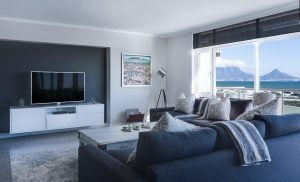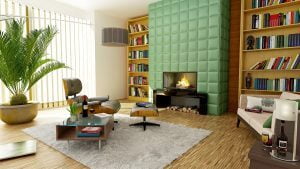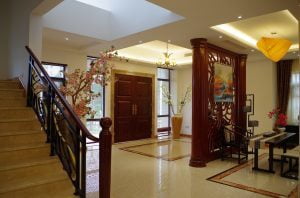A growing movement worldwide sees architects and designers choosing a more environmentally aware and responsible approach to building and interior design. Sustainability and significant reduction of carbon footprint are as important as aesthetics and budgets. Focus is still on comfortable, streamlined living, while at the same time there is emphasis on reducing negative impact on the environment as much as possible.
Designing for energy efficiency
- At the most basic we begin with energy efficient lighting. This is a good way to reduce electricity and to save on costs. LEDs offer many creative ways to light up areas in cool radiance. In addition, a solar energy system is the perfect choice for new buildings, offering renewable, non-carbon-based energy for both lighting and appliances.
- Heating and lighting are critical elements that must be incorporated into new designs. Double-glazed windows are beneficial because so much heat is lost through glass. Add window coverings in the form of curtains or blinds to support the insulation and you have eye-catching, arty techniques to control a building’s temperature in an energy efficient way.
- Carpets are excellent thermal insulators and help considerably to retain a room’s heat. Not only that, but they also add to the appeal of a room’s décor, adding a sense of warmth and comfort while saving on heating energy.
- The value of colour in reducing the need for extra lighting is a subtle factor that is sometimes ignored. Colour can add great reflective service to a dark room, lifting the brightness and the overall ambience while saving on unnecessary unnatural lighting
Designing for natural light
Larger windows capturing a full fall of natural light are essential wherever possible, but also important for human health. Spending day after day under electric lighting is considered detrimental on so many levels. Natural light is a natural health booster, mood enhancer, cost saver, and of course, environmentally friendly par excellence. Make sure to position surrounding décor requirements such as blinds and drapes to good effect, providing both coverage and control of temperature. Nothing is more inviting and cost-efficient than natural light!

Designing with natural textures
- Wood and stone flooring have long been favourites. They do not release any volatile organic compounds (VOC) and are much easier to clean. Preventing pollution in the atmosphere and allaying allergies are key advantages. Long-lasting and available in a variety of styles and colour, your flooring is the base to the rest of your design, and should be chosen to assure the least damage to the environment.
- An important eco aspect when planning your design is to follow the ‘origin route’ – in other words, keep a check on how materials are sourced. There are many labels and certifications that enable the environmentally sensitive designer to identify the origin of eco-friendly products, ensuring that the extraction, harvesting, production, transportation, and processing can be evaluated throughout all processes. Bamboo, for instance, is fast becoming an ecologically popular choice through both proven sustainable production and a variety of decorative uses.
Designing with natural textiles
With natural textiles you are going achieve a more comfortable and sustainable environment simply by avoiding synthetics, which are usually the product of the petroleum-based industry. Create soft warmth and relaxation when using wool, leather, cotton and silk to achieve durable textures that are classic in look and feel, and never too hot nor too cool to the touch. Aim to produce the ultimate in comfort in an eco-friendly way across a range of materials for pillows, upholstery, rugs, bedspreads and cushions, etc – natural choices that are less susceptible to fire, kinder to the touch, and in natural harmony with both humans and animals. Designing for waste reduction
Reuse and recycle are the watchwords in the new green movement currently sweeping through the design industry. This is probably one of the classic ways to be eco-friendly. While an eye for repurposing products is good, there are manufacturers who create remarkable furniture, furnishings, building materials and décor items solely reliant on a recycled process. Even waste material can be recycled for new use, especially with regard to synthetic materials which, if discarded, are thrown into landfills, potentially damaging the environment for years to come. It’s more environmentally expedient to keep such materials in the loop of continuous revision and use.Designing for longevity
- While considering the best eco-friendly materials, designers also have to consider the lifespan of that material. Resilience is key to sustainability because the idea is not to continually replace aspects such as flooring or furnishings every few years. Classic natural elements must be balanced with durability, quality and functionality.
- Décor should be flexible enough to be changed without renovating an entire house. Keeping spaces functional should be kept in mind when designing décor that may need to change as circumstances change, such as interlinking rooms that can be opened up as the need arises, or installing classic flooring that will blend with any new décor changes.
- Materials and surfaces should be designed with cleaning in mind; easy to clean means less money spent on harsh products that require frequent use.
Designing for better health
Materials less likely to emit air pollutants are now essential. In addition, heating, ventilation and noise can all be factors affecting health. Designs should incorporate good air circulation, tested carpets, easy cleaning, and natural light for both physical and psychological health.

